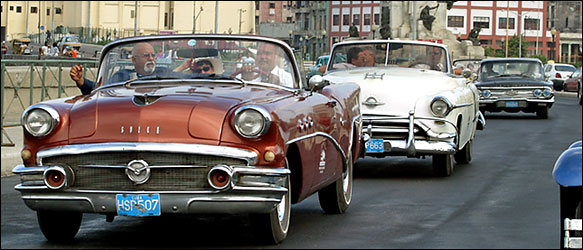As the kids pulled out of the driveway to start their trip home to Las Vegas earlier today, I thought about the fact that we and they drive nearly identical Chevy Trailblazers, and how well these cars serve us.
I started buying American in the early 90s. During the 60s, 70s, and 80s, I’d only buy European or Japanese; if you’d asked my opinion of American cars in those days I’d have said they were years behind the Europeans and Japanese in terms of quality and creature comforts. But starting around 20 years ago American cars got better (or at least that’s when I noticed they’d gotten better) and now I swear by them.
Before the kids arrived for the weekend, I read an entry on John Cole’s blog about American cars. He rented a Buick and liked it; reader comments, however, were overwhelmingly negative. People just don’t believe American cars hold up the way European and Japanese cars do.
Somewhere in the back of my mind, I’ve been thinking about that, and now the kids have gone home I have time to marshal some thoughts on the subject.
The notion that American cars don’t last is certainly pervasive, but is it true? Apart from Volvos, which appear to last damn near forever, do you really see disproportionate numbers of 15- to 20-year-old BMWs and Toyotas on the road compared to equally old Fords and Chevys? I don’t.

Reasonably frugal people today keep new cars eight to ten years, then pass them on their children, who drive them another five or so years before wrecking or wearing them out. This seems to me to be the case whether the car in question is European, Japanese, or American.
It also seems to me that reasonably frugal people take care of their cars, and that regular maintenance is a great equalizer when it comes to longevity. I put 140,000 miles on a 1994 Ford F-150 in 13 years, and apart from some sun-damaged paint it was as good as new when I sold it (which I only did because gas at the time had gotten up to nearly $4.00 a gallon). My wife’s 2002 Lincoln Town Car (over 100,000 miles now) is a brick, and so is our Trailblazer.
Of course cars do break down. They all do, now matter where they’re built. I can’t begin to count the horror stories I’ve heard from Mercedes-, BMW-, and Volvo-owning friends about the high cost of repairs (not to mention routine maintenance). I don’t hear stories like that from friends who own Toyotas or Hondas or Nissans, I’ll give the Japanese that . . . but then again I don’t hear stories like that from friends who own American cars either. I know that our American cars, on the rare occasions when we’ve had to repair them, haven’t forced us into bankruptcy. I’d much rather have a car I can afford to fix than one I can’t.
On the whole, I think the notion that American car quality lags behind European and Japanese car quality is no longer valid. It was true once; today it’s only “true” in the sense that a lot of people still believe it to be true, and refuse to consider buying American. Which is pretty damn true if you’re an unemployed American autoworker.
I’m certainly not saying I’m without prejudice: while I’d own and drive a GM or Ford product any day, I have what amounts to race memories of crappy Chrysler quality, and will probably never be able to bring myself to buy one no matter how good they get. And even though Hyundai reportedly now makes cars with Toyota-like quality, I can’t yet bring myself to believe it . . . will one of you let me know when you start seeing 15-year-old Hyundais on the road?
This isn’t the sort of thing I normally blog about, but I do believe in buying American, union-made products, and if I can convince one person to try American, maybe even buy American, it’s worth the effort.